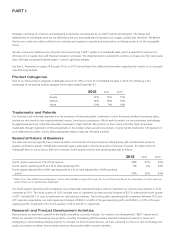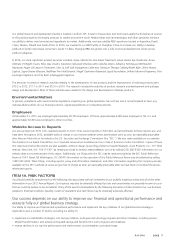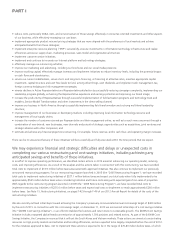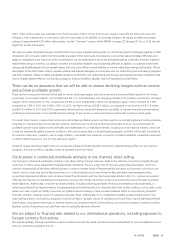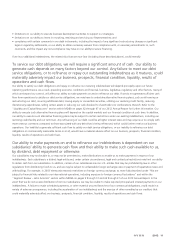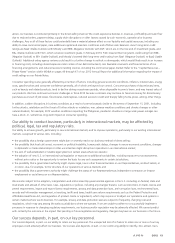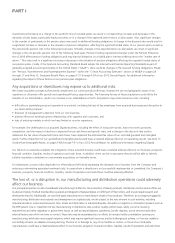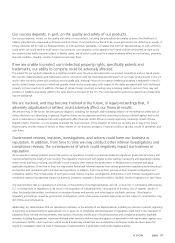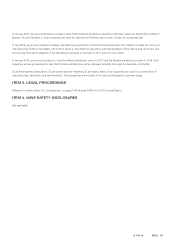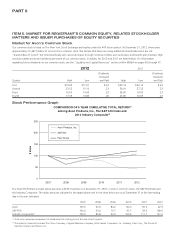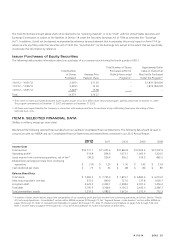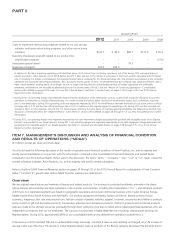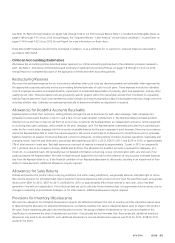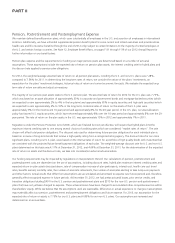Avon 2012 Annual Report Download - page 23
Download and view the complete annual report
Please find page 23 of the 2012 Avon annual report below. You can navigate through the pages in the report by either clicking on the pages listed below, or by using the keyword search tool below to find specific information within the annual report.PART I
investment performance or a change in the portfolio mix of invested assets can result in corresponding increases and decreases in the
valuation of plan assets, particularly equity securities, or in a change of the expected rate of return on plan assets. Also, significant changes
in the number of participants in the pension plans may result in additional funding obligations. A change in the discount rate would result in
a significant increase or decrease in the valuation of pension obligations, affecting the reported funded status of our pension plans as well as
the net periodic pension cost in the following fiscal years. Similarly, changes in the expected return on plan assets can result in significant
changes in the net periodic pension cost of the following fiscal years. Pension funding requirement changes under the Pension Protection
Act of 2006 affect pension funding obligations and may impose limitations on a hybrid plan’s interest crediting rate to the “market rate of
return.” This may result in a significant increase or decrease in the valuation of pension obligations affecting the reported funded status of
our pension plans. Finally, if the Financial Accounting Standards Board adopts the International Financial Reporting Standards as part of
generally accepted accounting principles in the United States (“GAAP”), there could be changes in the required funding obligations. Please
see “Pension, Postretirement and Postemployment Expense” within the “Critical Accounting Estimates” section of MD&A on pages 26
through 27 and Note 12, Employee Benefit Plans, on pages F-31 through F-39 of our 2012 Annual Report, for additional information
regarding the impact of these factors on our pension plan obligations.
Any acquisitions or divestitures may expose us to additional risks.
We review acquisition prospects that would complement our current product offerings, increase the size and geographic scope of our
operations or otherwise offer growth and operating efficiency opportunities. The financing for any of these acquisitions could dilute the
interests of our stockholders, result in an increase in our indebtedness or both. Acquisitions may entail numerous risks, including:
• difficulties in assimilating acquired operations or products, including the loss of key employees from acquired businesses and disruption to
our direct-selling channel;
• diversion of management’s attention from our core business;
• adverse effects on existing business relationships with suppliers and customers; and
• risks of entering markets in which we have limited or no prior experience.
For example, the challenges to our acquired Silpada business, including the effect of rising silver prices, macro-economic pressures,
competition, and the impact of declines in expected future cash flows and growth rates, and a change in the discount rate used to
determine the fair value of expected future cash flows, have impacted the estimated fair value of our recorded goodwill and intangible
assets. Further impairment of our goodwill and intangible assets could have a material adverse effect on our operating results. See Note 17,
Goodwill and Intangible Assets, on pages F-48 through F-51 of our 2012 Annual Report for additional information regarding Silpada.
Our failure to successfully complete the integration of any acquired business could have a material adverse effect on our business, prospects,
financial condition, liquidity, results of operations and cash flows. In addition, there can be no assurance that we will be able to identify
suitable acquisition candidates or consummate acquisitions on favorable terms.
For divestitures, success is also dependent on effectively and efficiently separating the divested unit or business from the Company and
reducing or eliminating associated overhead costs. In cases where a divestiture is not successfully implemented or completed, the Company’s
business, prospects, financial condition, liquidity, results of operations and cash flows could be adversely affected.
The loss of, or a disruption in, our manufacturing and distribution operations could adversely
affect our business.
Our principal properties consist of worldwide manufacturing facilities for the production of Beauty products, distribution centers where offices are
located and where finished merchandise is packed and shipped to Representatives in fulfillment of their orders, and one principal research and
development facility. Additionally, we use third-party manufacturers to manufacture certain of our products. Therefore, as a company engaged in
manufacturing, distribution and research and development on a global scale, we are subject to the risks inherent in such activities, including
industrial accidents, environmental events, fires, strikes and other labor or industrial disputes, disruptions in logistics or information systems (such as
the ERP system), loss or impairment of key manufacturing or distribution sites, product quality control issues, safety concerns, licensing
requirements and other regulatory or government issues, as well as natural disasters, pandemics, border disputes, acts of terrorism and other
external factors over which we have no control. These risks may be exacerbated by our efforts to increase facility consolidation covering our
manufacturing, distribution and supply footprints, which may require significant resources and be challenging to achieve, or if we are unable to
successfully enhance our disaster recovery planning. The loss of, or damage to, any of our facilities or centers, or those of our third-party
manufacturers, could have a material adverse effect on our business, prospects, financial condition, liquidity, results of operations and cash flows.


